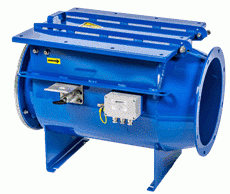
Explosion isolation flap valves are a cost effective passive solution installed to stop deflagration flame propagation to upstream areas through a dust collector inlet duct. Within the valve, there is a flap blade that rotates on a shaft and allows the valve to open and close. When process air flow is on, the flap blade rotates open. During a deflagration, the flap blade relies on the pressure wave of the propagating deflagration to rapidly close and lock the flap valve to prevent flame propagation upstream through the dust collector inlet duct.
NFPA and ATEX have strict requirements when it comes to flap valve usage. Explosivity data limitations, minimum and maximum installation distances, and elbow allowance are just a few of the valve limitations that must be considered. Appropriate sensors for valve closure and material accumulation are an NFPA 69 requirement. A significant but often overlooked factor is the low Kst value that the flap is approved for. The EN16447 standard which flap valves are tested against allows the flap valve manufacturer to use a Kst value as low as 50 bar-m/s. To be certified for a Kst lower than 50 bar-m/s, satisfactory full scale testing must be performed and certified to support the lower value. The challenge with low Kst approvals is the ability to get repeatable test properties. The result is most flap valve manufacturers rely on the default minimum Kst of 50 bar-m/s.
Another important limitation that gets overlooked is the auto-ignition temperature of the dust being handled. There are flap valves whose certification requires the dust auto-ignition temperature (AIT) to be much higher than most dusts found in industry. Using a flap valve that is not rated for applications with a lower AIT than approved for creates a risk that the valve will not adequately isolate a propagating fireball when needed.
All flap valve manufactures who have received ATEX approval will have a certificate stating what the specific conditions of use are that must be followed. The certificate is a multi-page document that may only be reproduced in its entirety and without change. It is imperative that you check these limits of applicability before risking installing a valve on an application that it is not suited for.
If you are considering installing an explosion isolation flap valve on your process please get in touch with us and we can review your application to ensure a flap valve is the right solution. Just because it is a low cost solution does not mean it is the correct solution. Together We Save Lives!


